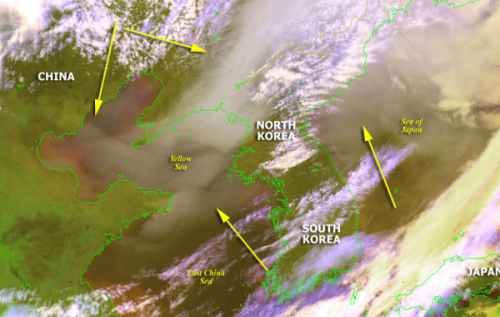 |
 |
| Home | Welcome | What's New | Site Map | Glossary | Weather Doctor Amazon Store | Book Store | Accolades | Email Us |
 | |||||||||
Asia Dusts Plankton BloomThey are not exactly dust bunnies and you won't find them under the sea bed, but airborne dust clouds from the deserts of Asia have triggered a bloom of phytoplankton — minute algae and other sea plants — in the North Pacific Ocean. And they might have given us a clue to slowing global warming. Phytoplankton populations and their carbon-fixing productivity depend on several environmental factors including sunlight, temperature and fertilizing nutrients. However, many marine biologists believe a lack of dissolved iron in ocean waters severely limits phytoplankton activity. That hypothesis was uniquely tested during Spring 2001. In April, NASA satellites identified and tracked a major duststorm, originating near China's Gobi Desert, as it moved over the North Pacific Ocean. The passing storm kicked up waves and deposited large quantities of iron-rich dust onto the sea surface.  Satellite Photo: 8 April 2002 Courtesy of NOAA, US Dept of Commerce [This April (2002) dust storm sent a cloud out of China and into the Pacific heading for our western coast. The tell-tale yellow stain from this soil tinted the air enough to make it visible to NASA satellites overhead. If you had looked skyward during the passing of that cloud, the sky would have appeared hazy white due to the scattering of sunlight by the dust particles (arrows in photo above). Storm was similar to the April 2001 event described in this article.] Fortunately, researchers from Lawrence Berkeley National Laboratory had just deployed two Carbon Explorer floats, instruments designed to determine phytoplankton growth by measuring carbon particles, in the ocean waters where the storm passed. In the two weeks following the duststorm's passage, phytoplankton biomass nearly doubled in the upper ocean waters, an immense bloom. A SeaWiFS satellite peering through the clouds saw the sea surface turn noticeably greener with increased phytoplankton chlorophyll. Phytoplankton ingest carbon dioxide during photosynthesis, thus removing it from the atmosphere. Some scientists believe that one solution to the problem of excess atmospheric carbon dioxide could be to fertilize the oceans with iron particles to stimulate phytoplankton growth and numbers. Whether this would help slow global warming remains problematic, as the full process is not well understood. "There's a huge amount of science left to be done," oceanographer James Bishop cautioned. "We've only scratched the surface." [This essay, authored by Keith C. Heidorn, PhD, originally aired on The Weather Notebook on 9 April 2003.] Learn More From These Relevant Books
|
|||||||||
 |
To Purchase Notecard, |
Now Available! Order Today! | |
 |
 |
NEW! Now |
The BC Weather Book: |


